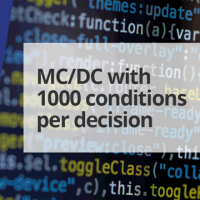It's true that some expressions are amenable to restructuring, and such restructuring might reduce the effort involved in creating test-cases for the sole purpose of achieving MC/DC. However, you should consider the consequences of restructuring code for this purpose. In the case of a simple and statement (in C):
if (a && b) {
code1();
} else {
code2();
}
You could rewrite the expression to eliminate the multiple condition as below:
if (a) {
if (b) {
code1();
} else {
code2();
}
} else {
code2();
}
Or for a different example (this time in Ada):
if a or else b then
code1;
else
code2;
end if;
becomes
if a then
code1;
else
if b then
code1;
else
code2;
end if;
end if;
Now code is being repeated, it's harder to review the circumstances under which a particular piece of code runs, and the traceability to the requirements just got a whole lot trickier.
The other thing that you might notice about the above two examples is that you haven’t reduced the number of test cases that are required. In the first version of the first example, you would need the following test vectors to achieve MC/DC:
| a | b | |
| V1 | TRUE | TRUE |
| V2 | TRUE | FALSE |
| V3 | FALSE | TRUE (or don’t care if you’re using masking MC/DC) |
(V1 and V3 test condition ‘a’, and V1 and V2 test condition ‘b’)
For the second version of the first example, you would need to test a with TRUE and FALSE, and to test b with TRUE and FALSE. This leads to exactly the same set of test cases as for the first version. A similar situation applies in the second example.

 Rapita System Announces New Distribution Partnership with COONTEC
Rapita System Announces New Distribution Partnership with COONTEC
 Rapita partners with Asterios Technologies to deliver solutions in multicore certification
Rapita partners with Asterios Technologies to deliver solutions in multicore certification
 SAIF Autonomy to use RVS to verify their groundbreaking AI platform
SAIF Autonomy to use RVS to verify their groundbreaking AI platform
 How to measure stack usage through stack painting with RapiTest
How to measure stack usage through stack painting with RapiTest
 What does AMACC Rev B mean for multicore certification?
What does AMACC Rev B mean for multicore certification?
 How emulation can reduce avionics verification costs: Sim68020
How emulation can reduce avionics verification costs: Sim68020
 Multicore timing analysis: to instrument or not to instrument
Multicore timing analysis: to instrument or not to instrument
 How to achieve multicore DO-178C certification with Rapita Systems
How to achieve multicore DO-178C certification with Rapita Systems
 How to achieve DO-178C certification with Rapita Systems
How to achieve DO-178C certification with Rapita Systems
 Certifying Unmanned Aircraft Systems
Certifying Unmanned Aircraft Systems
 DO-278A Guidance: Introduction to RTCA DO-278 approval
DO-278A Guidance: Introduction to RTCA DO-278 approval
 Certification-Ready Rust: GNAT Pro & RVS for Avionics Standards
Certification-Ready Rust: GNAT Pro & RVS for Avionics Standards
 DO-178C Multicore In-person Training (Toulouse)
DO-178C Multicore In-person Training (Toulouse)
 HISC 2025
HISC 2025


















